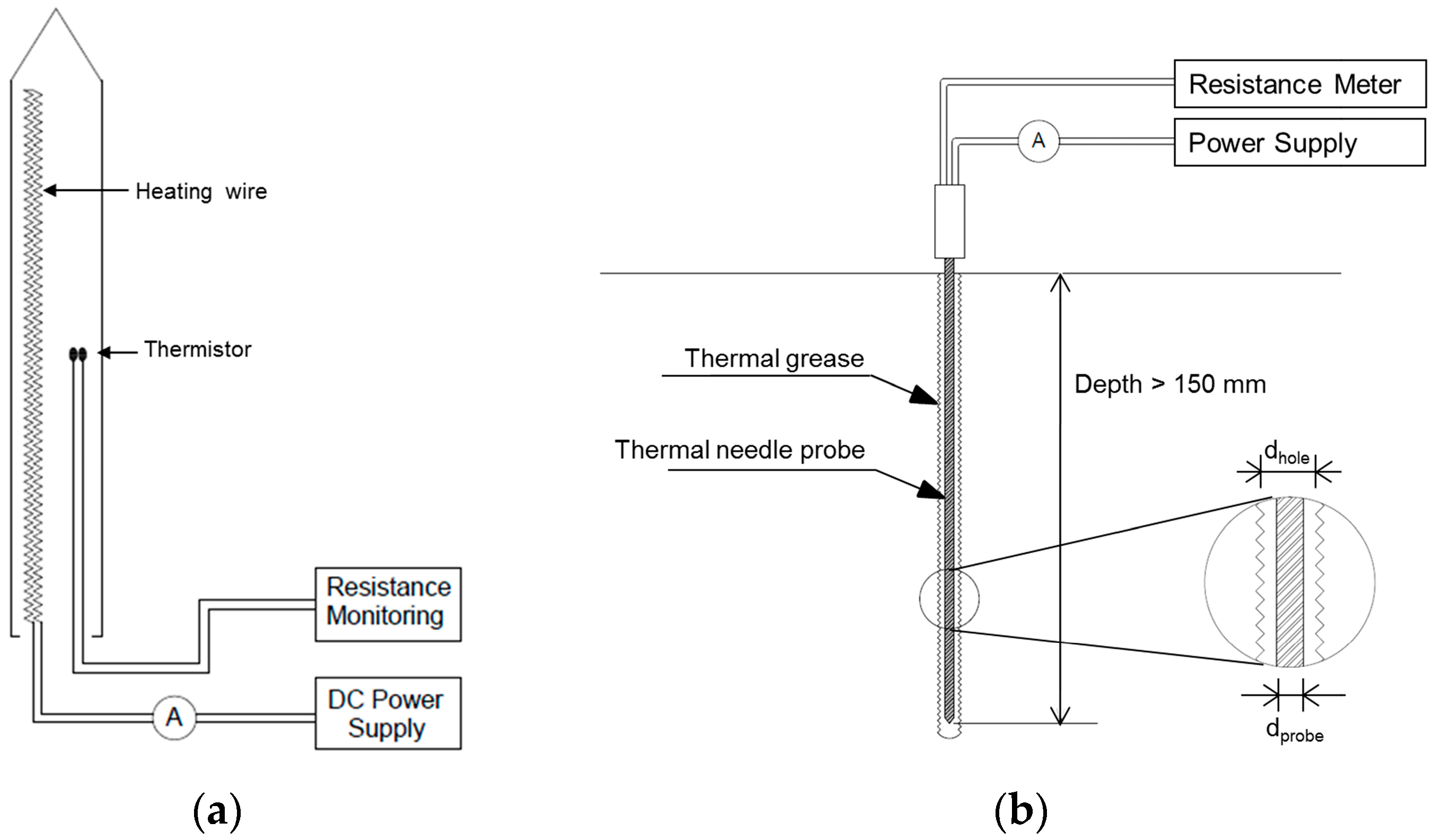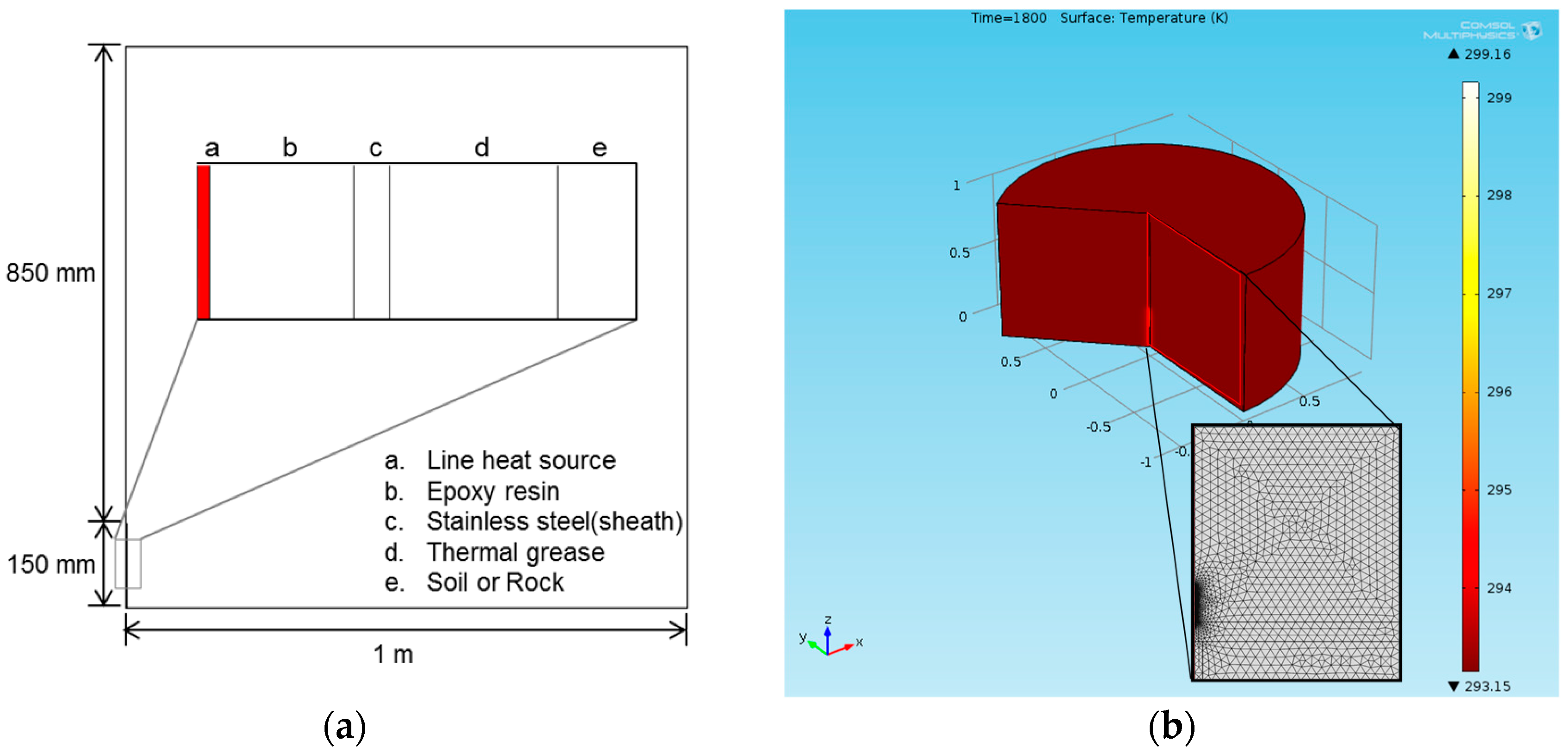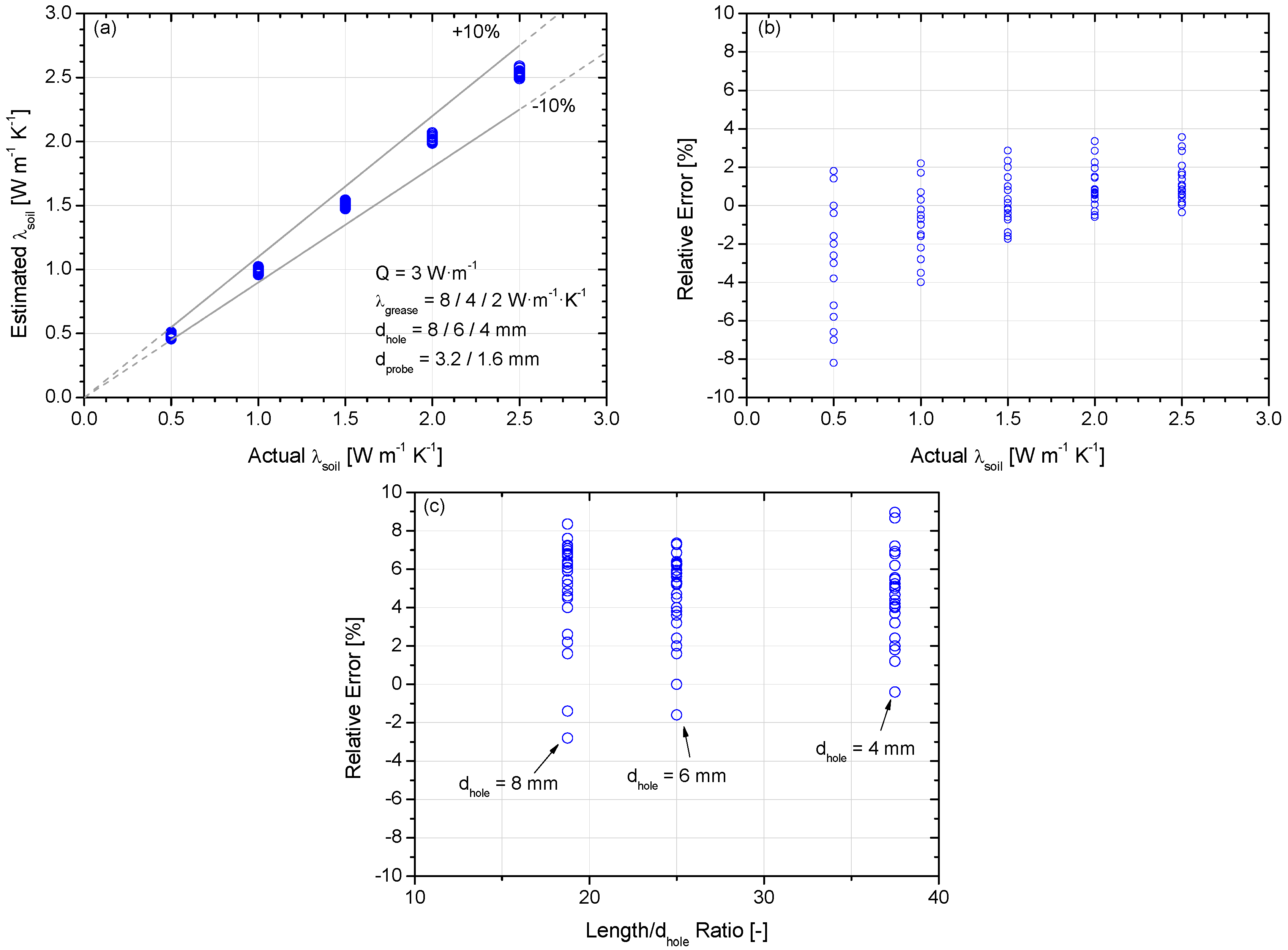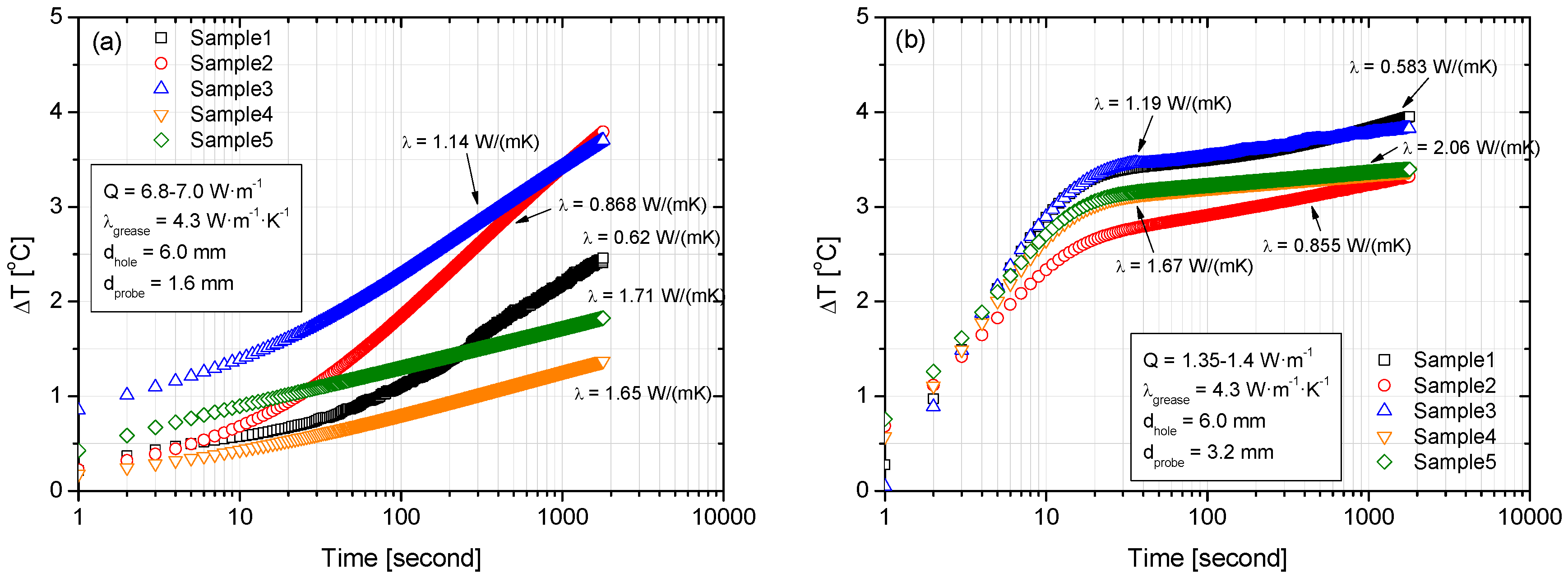Use of a Pre-Drilled Hole for Implementing Thermal Needle Probe Method for Soils and Rocks
Abstract
:1. Introduction
2. Materials and Methods
2.1. Numerical Simulation: Geometry and Mesh Configuration
2.2. Experimental Program
2.2.1. Sample Preparation
2.2.2. Measurement Procedures
3. Results and Discussion
3.1. Effects of Drilled Hole Diameter, Probe Diameter, and Thermal Conductivity of Thermal Grease: Observations from Numerical Simulations
3.2. Estimation of Thermal Conductivity: Observations from Numerical Simulations
3.3. Verification Using Physical Experiments
4. Conclusions
Acknowledgments
Author Contributions
Conflicts of Interest
References
- Carslaw, H.S.; Jaeger, J.C. Conduction of Heat in Solids, 2nd ed.; Oxford University Press: London, UK, 1959; pp. 1–455. [Google Scholar]
- Incropera, F.P.; Burkhard, S. Fundamentals of Heat and Mass Transfer, 4th ed.; John Wiley and Sons: Hoboken, NJ, USA, 1996; pp. 1–241. [Google Scholar]
- Chen, S.X. Thermal conductivity of sands. Heat Mass Transf. 2008, 44, 1241–1246. [Google Scholar] [CrossRef]
- Yun, T.S.; Santamarina, J.C. Fundamental study of thermal conduction in dry soils. Granul. Matter 2008, 10, 197–207. [Google Scholar] [CrossRef]
- Nasirian, A.; Cortes, D.D.; Dai, S. The physical nature of thermal conduction in dry granular media. Géotech. Lett. 2015, 5, 1–5. [Google Scholar] [CrossRef]
- Kumai, W.; Hashimoto, I.; Ohsawa, S.; Mitani, M.; Matsuda, Y. Completion of high-efficiency water pipe cooling system for underground transmission line. IEEE Trans. Power Deliv. 1994, 9, 585–590. [Google Scholar] [CrossRef]
- Brandl, H. Energy foundations and other thermos-active ground structures. Géotechnique 2006, 56, 81–122. [Google Scholar] [CrossRef]
- Johnston, I.W.; Narsilio, G.A.; Colls, S. Emerging geothermal energy technologies. KSCE J. Civ. Eng. 2011, 15, 643–653. [Google Scholar] [CrossRef]
- Choi, J.C.; Lee, S.R.; Lee, D.S. Numerical simulation of vertical ground heat exchangers: Intermittent operation in unsaturated soil conditions. Comput. Geotech. 2011, 38, 949–958. [Google Scholar] [CrossRef]
- Sass, J.H.; Stone, C.; Munroe, R.J. Thermal conductivity determinations on solid rock—A comparison between a steady-state divided-bar apparatus and a commercial transient line-source device. J. Volcanol. Geotherm. Res. 1984, 20, 145–153. [Google Scholar] [CrossRef]
- Van Der Held, E.F.M.; Van Drunen, F.G. A method of measuring thermal conductivity of liquids. Physica 1949, 15, 865–881. [Google Scholar] [CrossRef]
- Blackwell, J.H. The axial-flow error in the thermal conductivity probe. Can. J Phys. 1956, 34, 412–417. [Google Scholar] [CrossRef]
- Von Herzen, R.; Maxwell, A.E. The measurement of thermal conductivity of deep-sea sediments by a needle-probe method. J. Geophys. Res. 1959, 64, 1557–1563. [Google Scholar] [CrossRef]
- Woodside, W.M.J.H.; Messmer, J.H. Thermal conductivity of porous media. I. Unconsolidated sands. J. Appl. Phys. 1961, 32, 1688–1699. [Google Scholar] [CrossRef]
- Jones, B.W. Thermal conductivity probe: Development of method and application to a coarse granular medium. J. Phys. E Sci. Instrum. 1988, 21, 832–839. [Google Scholar] [CrossRef]
- Gori, F.; Marino, C.; Pietrafesa, M. Experimental measurements and theoretical predictions of the thermal conductivity of two phases glass beads. Int. Commun. Heat Mass. 2001, 28, 1091–1102. [Google Scholar] [CrossRef]
- Go, G.H.; Lee, S.R.; Kim, Y.S.; Park, H.K.; Yoon, S. A new thermal conductivity estimation model for weathered granite soils in Korea. Geomech. Eng. 2014, 6, 359–376. [Google Scholar] [CrossRef]
- Standard Test Method for Determination of Thermal Conductivity by Thermal Needle Probe Procedure; ASTM D5334-14; ASTM International: West Conshohocken, PA, USA, 2014.
- COMSOL. COMSOL Multiphysics User’s Guide (Version 4.2a); COMSOL Inc.: Stockholm, Sweden, 2011. [Google Scholar]
- Park, H.; Lee, S.R.; Yoon, S.; Shin, H.; Lee, D.S. Case study of heat transfer behavior of helical ground heat exchanger. Energy Build. 2012, 53, 137–144. [Google Scholar] [CrossRef]
- Yoon, S.; Lee, S.R.; Go, G.H. A numerical and experimental approach to the estimation of borehole thermal resistance in ground heat exchanger. Energy 2014, 71, 547–555. [Google Scholar] [CrossRef]
- Kaminski, W. Hyperbolic heat conduction equation for materials with a nonhomogeneous inner structure. J. Heat Transf. 1990, 112, 555–560. [Google Scholar] [CrossRef]






| Material | Thermal Conductivity λ (W∙m−1∙K−1) | Specific Heat Capacity Cp (J∙kg−1∙K−1) | Density ρ (kg∙m−3) | Thickness for Thick Sensor (mm) | Thickness for Thin Sensor (mm) |
|---|---|---|---|---|---|
| Stainless steel | 16.2 | 501 | 7850 | 0.3 | 0.3 |
| Epoxy | 0.35 | 1000 | 1271.5 | 1.3 | 0.5 |
| Thermal grease | 8 | 900 | 4000 | 0.4 | 1.2 |
| 4 | 900 | 2000 | 1.4 | 2.2 | |
| 2 | 900 | 1000 | 2.4 | 3.2 | |
| Soil 1 | 0.5 | 900 | 1600 | - | - |
| Soil 2 | 1 | 1100 | 1700 | - | - |
| Soil 3 | 1.5 | 1300 | 1800 | - | - |
| Soil 4 | 2 | 1500 | 1900 | - | - |
| Soil 5 | 2.5 | 1800 | 2000 | - | - |
| Sample Number | Mass of Mixtures (kg) | Estimated Porosity 2 (%) | Estimated Water Saturation 3 (%) | Reference Thermal Conductivity (W∙m−1∙K−1) | ||
|---|---|---|---|---|---|---|
| Sand | Gypsum Plaster 1 | Water | ||||
| 1 | 10.4 | 1.6 | 1.064 | 27.4 | 0 | 0.563 |
| 2 | 9.1 | 1.078 | 0.7 | 37.0 | 0 | 0.945 |
| 3 | 9.1 | 2.156 | 1.4 | 28.5 | 0 | 1.165 |
| 4 | 9.1 | 2.8 | 2.8 | 16.5 | 75 | 1.710 |
| 5 | 9.1 | 2.8 | 3.5 | 21.5 | 95 | 1.820 |
| λgrease (W∙m−1∙K−1) | dhole (mm) | λsoil (W∙m−1∙K−1) | Thick Sensor | Thin Sensor | ||
|---|---|---|---|---|---|---|
| λcalculated (W∙m−1∙K−1) | Relative Error (%) | λcalculated (W∙m−1∙K−1) | Relative Error (%) | |||
| 8 | 8 | 0.5 | 0.467 | −6.6 | 0.459 | −8.2 |
| 1 | 0.972 | −2.8 | 0.96 | −4.0 | ||
| 1.5 | 1.489 | −0.7 | 1.474 | −1.7 | ||
| 2 | 2.012 | 0.6 | 1.994 | −0.3 | ||
| 2.5 | 2.534 | 1.4 | 2.514 | 0.6 | ||
| 6 | 0.5 | 0.471 | −5.8 | 0.465 | −7.0 | |
| 1 | 0.978 | −2.2 | 0.965 | −3.5 | ||
| 1.5 | 1.494 | −0.4 | 1.476 | −1.6 | ||
| 2 | 2.013 | 0.6 | 1.99 | −0.5 | ||
| 2.5 | 2.525 | 1.0 | 2.501 | 0.0 | ||
| 4 | 0.5 | 0.481 | −3.8 | 0.474 | −5.2 | |
| 1 | 0.985 | −1.5 | 0.972 | −2.8 | ||
| 1.5 | 1.498 | −0.1 | 1.479 | −1.4 | ||
| 2 | 2.011 | 0.6 | 1.988 | −0.6 | ||
| 2.5 | 2.515 | 0.6 | 2.491 | −0.4 | ||
| 4 | 8 | 0.5 | 0.467 | −6.6 | 0.49 | −2.0 |
| 1 | 0.972 | −2.8 | 0.998 | −0.2 | ||
| 1.5 | 1.489 | −0.7 | 1.515 | 1.0 | ||
| 2 | 2.012 | 0.6 | 2.045 | 2.3 | ||
| 2.5 | 2.534 | 1.4 | 2.571 | 2.8 | ||
| 6 | 0.5 | 0.492 | −1.6 | 0.487 | −2.6 | |
| 1 | 0.998 | −0.2 | 0.99 | −1.0 | ||
| 1.5 | 1.512 | 0.8 | 1.502 | 0.1 | ||
| 2 | 2.029 | 1.5 | 2.017 | 0.8 | ||
| 2.5 | 2.543 | 1.7 | 2.527 | 1.1 | ||
| 4 | 0.5 | 0.49 | −2.0 | 0.485 | −3.0 | |
| 1 | 0.993 | −0.7 | 0.984 | −1.6 | ||
| 1.5 | 1.53 | 2.0 | 1.491 | −0.6 | ||
| 2 | 2.014 | 0.7 | 2.001 | 0.0 | ||
| 2.5 | 2.519 | 0.8 | 2.504 | 0.2 | ||
| 2 | 8 | 0.5 | 0.509 | 1.8 | 0.507 | 1.4 |
| 1 | 1.022 | 2.2 | 1.017 | 1.7 | ||
| 1.5 | 1.543 | 2.9 | 1.535 | 2.3 | ||
| 2 | 2.067 | 3.4 | 2.057 | 2.9 | ||
| 2.5 | 2.589 | 3.6 | 2.577 | 3.1 | ||
| 6 | 0.5 | 0.5 | 0.0 | 0.498 | −0.4 | |
| 1 | 1.007 | 0.7 | 1.003 | 0.3 | ||
| 1.5 | 1.522 | 1.5 | 1.515 | 1.0 | ||
| 2 | 2.039 | 2.0 | 2.03 | 1.5 | ||
| 2.5 | 2.552 | 2.1 | 2.54 | 1.6 | ||
| 4 | 0.5 | 0.492 | −1.6 | 0.49 | −2.0 | |
| 1 | 0.995 | −0.5 | 0.99 | −1.0 | ||
| 1.5 | 1.505 | 0.3 | 1.497 | −0.2 | ||
| 2 | 2.016 | 0.8 | 2.007 | 0.4 | ||
| 2.5 | 2.521 | 0.8 | 2.51 | 0.4 | ||
| Sample Number | Reference λ (W∙m−1∙K−1) | λ Estimated by the Thin Sensor (W∙m−1∙K−1) | Relative Error (%) | λ Estimated by the Thick Sensor (W∙m−1∙K−1) | Relative Error (%) |
|---|---|---|---|---|---|
| 1 | 0.563 | 0.620 | −10.1 | 0.583 | −3.6 |
| 2 | 0.945 | 0.868 | 8.1 | 0.855 | 9.5 |
| 3 | 1.17 | 1.14 | 2.6 | 1.19 | −1.7 |
| 4 | 1.71 | 1.65 | 3.5 | 1.67 | 2.3 |
| 5 | 1.82 | 1.71 | 6.0 | 2.06 | −13.2 |
© 2016 by the authors; licensee MDPI, Basel, Switzerland. This article is an open access article distributed under the terms and conditions of the Creative Commons Attribution (CC-BY) license (http://creativecommons.org/licenses/by/4.0/).
Share and Cite
Lee, S.-J.; Choi, J.-C.; Baek, S.; Kwon, T.-H.; Ryu, H.-H.; Song, K.-I. Use of a Pre-Drilled Hole for Implementing Thermal Needle Probe Method for Soils and Rocks. Energies 2016, 9, 846. https://doi.org/10.3390/en9100846
Lee S-J, Choi J-C, Baek S, Kwon T-H, Ryu H-H, Song K-I. Use of a Pre-Drilled Hole for Implementing Thermal Needle Probe Method for Soils and Rocks. Energies. 2016; 9(10):846. https://doi.org/10.3390/en9100846
Chicago/Turabian StyleLee, So-Jung, Jung-Chan Choi, Seunghun Baek, Tae-Hyuk Kwon, Hee-Hwan Ryu, and Ki-Il Song. 2016. "Use of a Pre-Drilled Hole for Implementing Thermal Needle Probe Method for Soils and Rocks" Energies 9, no. 10: 846. https://doi.org/10.3390/en9100846







